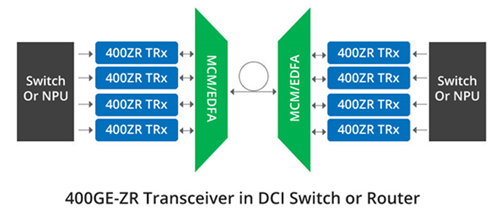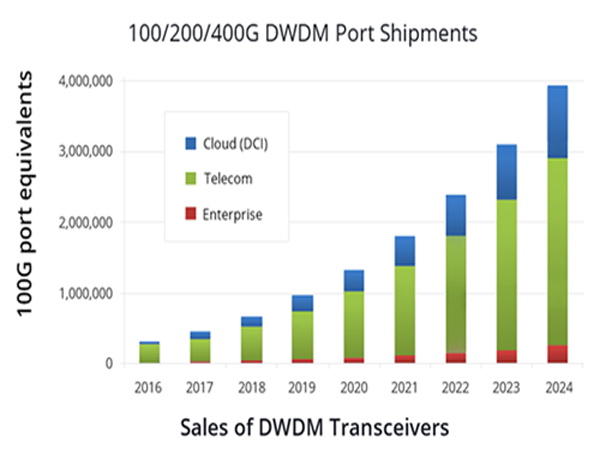
With the increasing demand for large-scale cloud services and data center storage and processing, data center systems are becoming more and more decentralized and therefore more difficult to manage. In addition, applications such as artificial intelligence (AI) urgently need low latency, high bandwidth network architectures to handle the large machine-to-machine input/output (I/O) requirements generated between servers. To ensure that these applications can be implemented, the maximum transmission distance between these distributed data centers must be limited to about 100km. So these data centers must be connected in clusters. In order to ensure the interconnection between high-bandwidth and high-density data centers, 400ZR was born. This paper will focus on introducing the definition, influence and development trend of 400ZR.
What is 400ZR?

400G ZR presents a unique and advanced coherent technology that drives a high-capacity data transmission solution. It is small, compact, hot-pluggable, and can be matched with 400GE switching ports. Although the external dimensions of the module are not specified in IA (Implementation Protocol), the optical Internet forum OIF has defined the dimensions of the module to accommodate the 400G solution. In addition, the Multi-source protocol (MSA) body has defined optical modules of the QSFP-DD and OSFP encapsulation types, which can be interlinked. In other words, since the OIF and MSA are industry-wide organizations, the marketed compliant 400ZR solution will also be interoperable. The interoperability of the 400ZR solution also brings the dual benefits of simplifying supply chain management and deployment.
The hot-pluggable coherent 400ZR scheme supports only 400G Ethernet interconnections and multi-vendor interconnections. It is not suitable for next generation 400G MAN transmissions over 80km. In this case, the 400ZR+ (400G ZR+) standard is proposed, which promises to further improve modularity by supporting a variety of channel capacities based on coverage requirements and compatibility with established MAN infrastructures.
What will be the impact of 400ZR?
Although the 400ZR technology is still in its infancy, it will have a major impact on three industries, including very large data centers, distributed campus networks and metropolitan area networks, and telecommunications providers.
demand for high bandwidth
2. The 400ZR will support the connectivity of distributed data centers
As mentioned above, the 400ZR technology will support high bandwidth interconnections to connect distributed data centers. Through this connection, distributed data centers can communicate with each other, share data, balance workloads, provide backups, and expand data center capacity when needed.
3. The 400ZR will allow telecommunications companies to send back residential traffic
The 400G ZR standard will allow telecommunications companies to send back residential traffic. When running at 200Gb/s, the 400ZR can increase the range of high-loss transmissions using 64Gbaud heart and QPSK modulation. For 5G networks, 400G ZR can provide mobile backhaul by aggregating multiple 25Gb/s links, which is more conducive to promoting the expansion of the emerging 5G network market and application scope.
4. 400ZR+/400ZR- will provide more convenience on top of 400ZR
In addition to its interoperability with other modules, the 400ZR is expected to support additional operational modes, known as 400ZR+ and 400ZR-, to increase the range of addressable applications. The "+" indicates that the module‘s power consumption exceeds the 15W required by IA and some pluggable devices, enabling the module to transmit over distances of hundreds of kilometers using more powerful signal processing technologies. "-" means that the module can support low rate modes such as 300G, 200G and 100G, providing more flexibility and convenience for network operators.
How long will the 400ZR heat last?
According to the 2019 OFC chief technology officer, a 400ZR product sample is expected to be seen on the 2020 OFC. At the OFC data center summit in 2019, Google, Microsoft and other industry giants announced plans to deploy the 400ZR within the next two years.

In addition, with the implementation of the first 100Gbps serialize/desiccator on a switching chip in 2021, the transfer rate required for the optical interface will shift to 800Gbps in the next 1-2 years. OSFP dimensions have been defined to support a rate of 8x100GE without changing the type of optical module encapsulation. At the same time, the line-side coherent optics will transition to 128GBaud 16QAM support in the same amount of time, making it easy to upgrade from the current 400ZR to the next generation 800ZR. Therefore, 400ZR is crucial in both current and future network development.